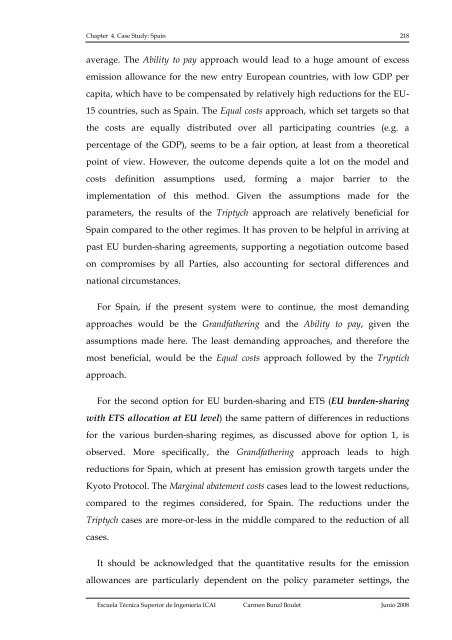Carmen Bunzl - Universidad Pontificia Comillas
Carmen Bunzl - Universidad Pontificia Comillas
Carmen Bunzl - Universidad Pontificia Comillas
You also want an ePaper? Increase the reach of your titles
YUMPU automatically turns print PDFs into web optimized ePapers that Google loves.
Chapter 4. Case Study: Spain 218<br />
average. The Ability to pay approach would lead to a huge amount of excess<br />
emission allowance for the new entry European countries, with low GDP per<br />
capita, which have to be compensated by relatively high reductions for the EU-<br />
15 countries, such as Spain. The Equal costs approach, which set targets so that<br />
the costs are equally distributed over all participating countries (e.g. a<br />
percentage of the GDP), seems to be a fair option, at least from a theoretical<br />
point of view. However, the outcome depends quite a lot on the model and<br />
costs definition assumptions used, forming a major barrier to the<br />
implementation of this method. Given the assumptions made for the<br />
parameters, the results of the Triptych approach are relatively beneficial for<br />
Spain compared to the other regimes. It has proven to be helpful in arriving at<br />
past EU burden-sharing agreements, supporting a negotiation outcome based<br />
on compromises by all Parties, also accounting for sectoral differences and<br />
national circumstances.<br />
For Spain, if the present system were to continue, the most demanding<br />
approaches would be the Grandfathering and the Ability to pay, given the<br />
assumptions made here. The least demanding approaches, and therefore the<br />
most beneficial, would be the Equal costs approach followed by the Tryptich<br />
approach.<br />
For the second option for EU burden-sharing and ETS (EU burden-sharing<br />
with ETS allocation at EU level) the same pattern of differences in reductions<br />
for the various burden-sharing regimes, as discussed above for option 1, is<br />
observed. More specifically, the Grandfathering approach leads to high<br />
reductions for Spain, which at present has emission growth targets under the<br />
Kyoto Protocol. The Marginal abatement costs cases lead to the lowest reductions,<br />
compared to the regimes considered, for Spain. The reductions under the<br />
Triptych cases are more-or-less in the middle compared to the reduction of all<br />
cases.<br />
It should be acknowledged that the quantitative results for the emission<br />
allowances are particularly dependent on the policy parameter settings, the<br />
Escuela Técnica Superior de Ingeniería ICAI <strong>Carmen</strong> <strong>Bunzl</strong> Boulet Junio 2008

















